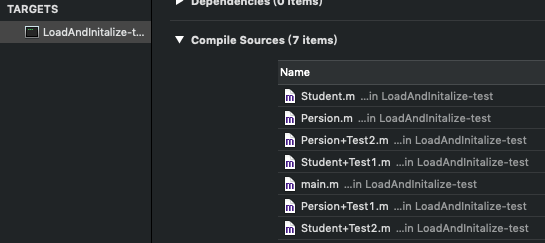思考:
- Category 中有 +load 方法吗?+load 方法是什么时候调用的?+load 方法能继承吗?
+load 方法会在 runtime 加载类、分类时调用。每个类、分类的 +load 方法,在程序运行过程中只调用一次。
定义 Persion、Persion+Test1 和 Persion+Test2
|
|
编译顺序:
打印结果:
从打印结果👆可以看出:
- 类和分类里的 +load 方法都会被调用
- +load 方法的调用顺序和编译顺序是一致的
- Persion (Test1) 最后被编译,所以优先调用 Persion (Test1) 里的 +test 方法
objc4 源码解读过程
objc-os.mm
_objc_init
load_imagesprepare_load_methods
schedule_class_load
add_class_to_loadable_list
add_category_to_loadable_listcall_load_methods
call_class_loads
call_category_loads
(*load_method)(cls, SEL_load)
打开 runtime 源码 objc4-781。找到运行时入口 objc-os.mm 文件,打开文件找到运行时的初始化方法 void _objc_init(void) 方法:
+ load 方法的调用流程
_objc_init
runtime 的初始化方法:
load_images
Jump To Definition -> load_images(加载类信息):
Call +load methods. 可以看出 call_load_methods() 方法里调用了 +load 方法。
call_load_methods
Jump To Definition -> call_load_methods(调用 +load 方法):
call_load_methods 方法中先调用了 call_class_loads 方法去调用“类”的 +load 方法,后调用了 call_category_loads 去调用“分类”的 +load 方法。
call_class_loads
Jump To Definition -> call_class_loads(调用“类”的 +load 方法):
call_category_loads
Jump To Definition -> call_category_loads(调用“分类”的 +load 方法):
小结
在上面👆出现的 call_class_loads 和 call_category_loads 方法中,cats / classes 是存放着类 / 分类的数组。cats[i].method / classes[i].method 即取出类 / 分类里的 +load 方法,然后通过
*load_method)(cls, @selector(load))方法进行调用。因为在 call_load_methods 方法中,是按照 call_class_loads()、call_category_loads() 顺序调用的,所以打印日志里先调用“类”里的 +load 方法,再调用“分类”里的 +load 方法。
cats[i].method / classes[i].method 调用的 method 方法就是 +load 方法。
至于分类 +load 方法的调用顺序,以及子类 +load 方法的调用顺序,还得看一下 prepare_load_methods 方法👇。
子类的 +load 方法
定义 Student : Persion
|
|
编译顺序:
打印结果:
通过”+load 方法的调用过程”知道了 call_load_methods 是调用 +load 方法的入口。而在 load_images 方法中还有一个 prepare_load_methods 方法是在 call_load_methods 方法前调用的。从命名上可以猜到,prepare_load_methods 方法是在调用 call_load_methods 方法之前做一些准备工作的方法。
prepare_load_methods
获取并保存所有的类和分类。
Jump To Definition -> prepare_load_methods:
_getObjc2NonlazyClassList 方法是获取到所有的类。
_getObjc2NonlazyCategoryList 方法是获取到所有的分类。
schedule_class_load 方法内部调用了一个 add_class_to_loadable_list 方法,是将类 cls 及其父类添加到 loadable_classes 数组中。
add_category_to_loadable_list 方法是将分类 cat 添加到 loadable_categories 数组中。
schedule_class_load
通过递归,通过 add_class_to_loadable_list 方法,将类 cls 的父类及其自身添加到 loadable_classes 数组中。
Jump To Definition -> schedule_class_load:
schedule_class_load 方法内部通过 schedule_class_load(cls->superclass) 方法形成递归,优先让父类调用 schedule_class_load() 方法,添加的 loadable_classes 数组中,直到父类不存在时再处理类 cls。
在 schedule_class_load 方法的最后,通过修改类 cls 的 info 信息来标记已经加入到 loadable_classes 数组中了,避免重复操作。
add_class_to_loadable_list
将传入的 cls 类添加到 loadable_classes 数组中。
Jump To Definition -> add_class_to_loadable_list:
loadable_classes 可以理解为 runtime 中存储所有“类”的容器。
add_category_to_loadable_list
将传入的分类 cat 添加到 loadable_categories 数组中。
Jump To Definition -> add_category_to_loadable_list:
loadable_categories 可以理解为 runtime 中存储所有“分类”的容器。
Jump To Definition -> method:
+load 方法的调用顺序
类 +load > 分类 +load
因为 runtime 中 call_load_methods 方法里是按照 call_class_loads()、call_category_loads() 顺序调用的,所以是先调用类的 +load 方法,再调用分类的 +load 方法。
父类 +load > 子类 +load
在调用 call_class_loads 方法之前调用了 prepare_load_methods 方法用来加载所有的类。因为 prepare_load_methods 方法中的 schedule_class_load 方法在添加类时通过递归的方式优先找到该类的父类进行添加,所以在先调用类的 +load 方法的基础上,优先调用父类的 +load 方法,在调用子类的 +load 方法。
分类 +load 的调用顺序 == 编译顺序
在添加所有分类的时候,因为 prepare_load_methods 方法直接调用 add_category_to_loadable_list 方法进行了添加,所有在 call_category_loads 方法中获取分类并调用分类的 +load 方法的顺序就是分类的编译顺序。
小结
- runtime 会优先调用类的 +load 方法,调用时按照编译先后顺序调用(先编译,先调用)。对于有继承关系的类,在调用子类的 +load 方法之前会优先调用父类的 +load 方法。
- 在类的 +load 方法调用完成后再调用分类的 +load 方法,调用时按照编译先后顺序调用(先编译,先调用)。
类中的 +load 方法的调用流程:
12345_objc_init -> load_imagesload_images -> prepare_load_methods -> schedule_class_load -> add_class_to_loadable_listload_images -> call_load_methods -> call_class_loads分类中的 +load 方法的调用流程:
12345_objc_init -> load_imagesload_images -> prepare_load_methods -> add_category_to_loadable_listload_images -> call_load_methods -> call_category_loads
+load 方法与继承
定义 Student : Persion
|
|
打印结果:
[Student load] 的本质
[Student load] 这句代码本质就是 objc_msgSend(objc_getClass("Student"), sel_registerName("load")),即向 Student 类对象发送一条 “load” 消息,Student 类对象再通过 isa 指针找到 Student 元类对象去查找 +load 方法。因为 Student 里没有实现 +load 方法,所以 Student 元类对象会通过 superclass 指针找到父类 Persion 的元类对象 。Persion 的元类对象在查找 +load 方法时,会优先查找到最后被编译的分类 Persion (Test1),找到 +load 方法并调用。所以 +load 方法是可以被继承的。
+load 方法是可以被继承的。在启动时由 runtime 调用的 +load 方法是优先调用父类的 +load 方法。而通过 [Student load] 这种方式主动调用 +load 方法,是优先调用子类的 +load 方法。
总结
- Category 中有 +load 方法吗?+load 方法是什么时候调用的?+load 方法能继承吗?
Category 有 +load 方法。
+load 方法在 runtime 加载类、分类的时候调用。
+load 方法可以继承,但是一般情况下不会主动去调用 +load 方法,都是让系统启动时自动调用。